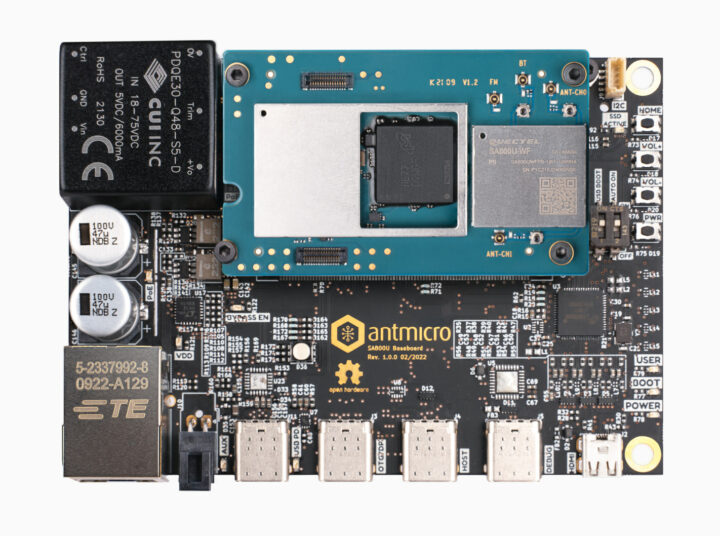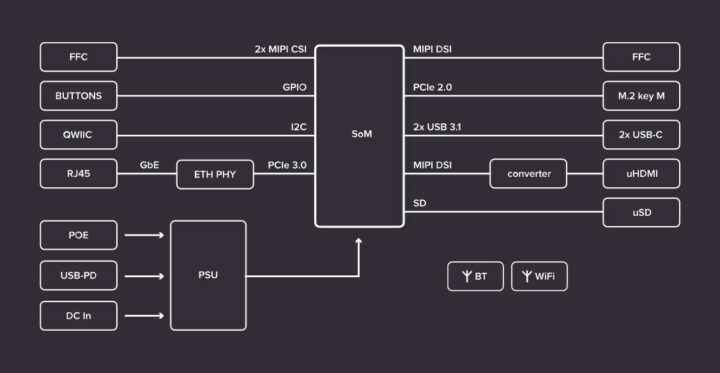Antmicro team has released an open-source hardware baseboard for Quectel SA800U-WF System-on-Module powered by Qualcomm Snapdragon 845 octa-core processor, which they designed with KiCad open-source EDA tool.
The baseboard supports NVMe storage and offers Micro HDMI and MIPI DSI video interfaces, Gigabit Ethernet with PoE support, USB 3.1 Type-C interfaces, and other I/Os, plus three separate power inputs. The company expects the design to serve as a starting point for building portable smart assistants, kiosks, VR/AR or smart screens, and more.
Antmicro Snapdragon 845 baseboard specifications:
- Supported system-on-module – Quectel SA800U-WF with:
- SoC – Qualcomm Snapdragon 845 octa-core Kryo 385 processor (4x Cortex A75 cores + 4x Cortex-A55 cores), Adreno 630 GPU, Hexagon 685 DSP, 4K H.265/H.264 video decoding and encoding
- System Memory – 4 GB LPDDR4X
- Storage – 64 GB UFS storage
- 802.11b/g/n/ac Wi-Fi 5 2×2 MIMO and Bluetooth 5.0 module
- Board-to-board connector for connection to baseboard
- Dimensions – 60.0 x 37.0 x 6.5 mm
- Weight – 15 grams
- Storage – M.2 key-M socket (PCIe 2.0) for optional external storage (M.2 SSD), MicroSD card socket
- Display I/F
- HDMI output implemented with on-board DSI-HDMI bridge
- MIPI DSI interface exposed on Flexible Flat Cable (FFC) connector
- Camera I/F – 2x 4-lane MIPI CSI-2 camera interfaces
- Networking – Gigabit Ethernet with PoE support
- USB
- USB 3.1 Type-C host/OTG port with optional DisplayPort video output
- USB 3.0 Type-C host port
- Debugging – USB Type-C port for debugging
- Misc – Qwiic I2C expansion connector, buttons
- Power Supply
- Power over Ethernet
- USB-C PD port
- External PSU or battery
You’ll find the KiCad and PDF schematics and other information on Github with everything released under a permissive Apache 2.0 license. Antmicro further highlights the design is completely free (zero cost license and royalty-free platform), and it appears they’ve done this to promote their services which include “complete hardware, software, AI, OTA and fleet management development services, from a product’s inception to mass deployment”. In any case, you are free to build on the design or ask Antmicro to help.
The Quectel SA800U-WF module ships with Android 9.0 or 10.0, but other companies are offering Linux BSPs for their Snapdragon 845-powered products, and that includes Qualcomm’s own Robotics RB3 Development Platform that runs Debian or OpenEmbedded. Antmicro also highlights support for AI-oriented frameworks such as TensorFlow, TensorFlow Lite or Caffe2 with processing accelerated with the GPU and Hexagon Vector Extensions.
It does not look like Antmicro intends to sell the board based on the information provided in the announcement.
Via Liliputing,

Jean-Luc started CNX Software in 2010 as a part-time endeavor, before quitting his job as a software engineering manager, and starting to write daily news, and reviews full time later in 2011.
Support CNX Software! Donate via cryptocurrencies, become a Patron on Patreon, or purchase goods on Amazon or Aliexpress






